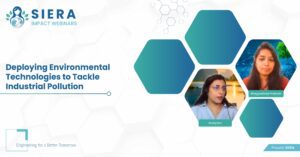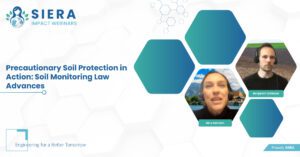Introduction: Groundwater – Europe’s Hidden Lifeline
Across the European continent, groundwater remains a silent guardian of sustainability. It supplies over 65% of drinking water and 25% of irrigation water, quietly sustaining life, agriculture, and industry. Yet, despite its vital role, this critical resource is being depleted, contaminated, and mismanaged at alarming rates. In some regions of the EU, groundwater bodies are failing to meet environmental and human needs due to poor chemical and quantitative status – posing a silent but growing threat to long-term water security.
On April 22, 2025, the SIERA Academy hosted a pivotal webinar as part of the Impact Series, titled “Sustainable Groundwater Management: Strategies for Long-Term Water Security”. This session focused on the challenges, opportunities, regulatory frameworks, and innovative solutions essential for preserving groundwater resources under growing climate and societal pressures.
Bringing together experienced professionals and thought leaders under the umbrella of SIERA Alliance, the webinar aimed to provide companies, policymakers, and infrastructure stakeholders with actionable insights for achieving groundwater sustainability while aligning with evolving EU regulations such as the Corporate Sustainability Reporting Directive (CSRD) and European Sustainability Reporting Standards (ESRS).
The Challenges: An Invisible Crisis Beneath Our Feet
Groundwater depletion is a creeping crisis. Because it remains unseen, its importance is often underestimated—until systems begin to fail.
SIERA Alliance Members highlighted four major areas of concern:
1. Over-Extraction and Aquifer Depletion
Groundwater abstraction across Europe is accelerating. In agricultural zones, 70% of extracted groundwater is used for irrigation, often exceeding natural recharge rates. This imbalance is exacerbated by:
- Unregulated private wells,
- Intensive farming,
- Industrial extraction, and
- Urban expansion.
In regions such as Southern Spain and Italy, aquifer levels are falling rapidly, threatening ecosystems and long-term water availability.
2. Widespread Contamination
Contaminants from agricultural runoff, industrial discharge, and urban waste systems infiltrate aquifers. Pollutants such as nitrates, pesticides, and heavy metals can persist for decades, posing threats to human health and biodiversity. Remediation is not only expensive but often unpredictable, with uncertain outcomes.
3. Data Gaps and Monitoring Deficits
Reliable groundwater data is critical for sustainable management, yet many regions suffer from poor monitoring infrastructure. Fragmented monitoring systems, lack of real-time tracking, and inconsistent data standards across EU Member States hinder coordination and transparency, impairing long-term planning and risk mitigation.
4. Inefficient Water Use and Inadequate Planning
Outdated irrigation systems, poor water infrastructure, and lack of integrated planning result in inefficient water use. Many Member States still fail to account for climate variability, seasonal droughts, or population growth in water strategies, compounding groundwater stress.
Regulatory Context: Groundwater in the CSRD & EU Water Policy
EU policy mandates stringent regulations to protect groundwater, positioning it within the core of the sustainability disclosure landscape:
- Water Framework Directive (2000/60/EC)
- Groundwater Directive (2006/118/EC)
- Environmental Liability Directive (2004/35/EC)
- REACH Regulation (EC 1907/2006)
- CSRD (2022 onwards)
These regulations are further reinforced through the ESRS environmental categories:
- E1 – Climate Change: Indirect impacts from climate-induced water stress
- E2 – Pollution: Direct contamination from industrial, agricultural, and landfill runoff
- E3 – Water Resources: Over-abstraction for irrigation or industry
- E4 – Biodiversity: Disruptions to wetland ecosystems and species dependent on aquifers
- E5 – Resource Use: Groundwater degradation limiting land reuse and economic activity
Organizations must disclose how they manage groundwater risks, impacts, and remediation costs. Failure to comply can result in penalties, legal exposure, and diminished ESG performance, while proactive action can unlock new financing avenues and improve stakeholder trust.
Opportunities: Turning Compliance into Competitive Advantage
While regulatory demands are rising, so too are the opportunities. Groundwater stewardship. The table below show that the challenges, when approached strategically, unlocks transformative opportunities.
| Opportunity Area | Description |
| Resilience & Resource Security | Stabilizing aquifer levels through artificial recharge and controlled extraction helps companies adapt to climate variability and ensures long-term water availability. |
| Public Health Protection | Monitoring and preventing contamination from pollutants like nitrates and PAHs reduces health risks to communities and improves environmental safety. |
| Cost Reduction & Operational Efficiency | Adoption of smart technologies and efficient water usage reduces costs for pumping, treatment, and infrastructure maintenance. |
| Access to Green Financing | Projects aligned with groundwater sustainability become eligible for EU Taxonomy-compliant loans, grants, and climate adaptation funds. |
| Improved Transparency & ESG Reputation | Real-time data systems enhance ESG reporting, increase accountability, and elevate brand value among investors and stakeholders. |
Sustainable Groundwater Management Solutions
The SIERA Alliance supports organizations across Europe in implementing forward-looking, scalable, and regulatory-aligned strategies for groundwater sustainability. These solutions are designed not only to mitigate risk and meet compliance obligations under the EU Water Framework Directive and CSRD but also to build long-term environmental and economic resilience.
1. Sustainable Groundwater Recharge and Extraction Management
Over-extraction of groundwater can lead to aquifer imbalance, land subsidence, and ecological degradation. To mitigate these risks, SIERA Alliance Members design artificial recharge systems using GIS and remote sensing technologies. These systems include check dams, recharge wells, and percolation tanks that enhance aquifer recharge during high precipitation periods. Aquifer recharge and recovery systems are integrated with stormwater harvesting to maximize natural infiltration. Detailed groundwater modelling allows stakeholders to simulate stress scenarios and forecast aquifer behavior over seasonal and long-term horizons. These models help define sustainable extraction limits that balance usage across agriculture, industry, and domestic needs while protecting ecological reserves.
2. Pollution Prevention and Groundwater Quality Protection
Contaminated groundwater can persist undetected for decades, creating health and environmental risks. SIERA Alliance Members apply remediation strategies tailored to the contamination profile of each site, using technologies such as bioremediation, chemical oxidation, and pump-and-treat systems. These methods are supported by pollution prevention measures including risk assessments, containment infrastructure, and emergency response planning. Real-time water quality monitoring using IoT-enabled sensors allows for continuous tracking of nitrate, metal, and chemical concentrations. Groundwater protection efforts are aligned with EU directives, ensuring compliance and long-term aquifer integrity.
3. Smart Groundwater Monitoring and Data Systems
Sustainable groundwater management requires reliable, real-time data. SIERA Alliance Members implement monitoring programs that combine IoT sensors, satellite imaging, and GIS platforms to track aquifer levels, recharge rates, and contamination risks. Centralized data management systems allow users to store, analyze, and visualize trends, facilitating proactive decision-making. Decision support tools synthesize hydrological models with real-time inputs to provide early warning alerts and dynamic water usage recommendations. These technologies help companies demonstrate due diligence and compliance in their ESRS and CSRD reports.
4. Efficient Water Use Planning and Conservation
Reducing groundwater demand is essential to long-term sustainability. SIERA Alliance promotes the deployment of water-saving technologies such as low-flow fixtures, smart irrigation systems, greywater reuse infrastructure, and leak detection solutions. Sustainable water use planning involves creating integrated strategies that account for regional population growth, climate variability, and sectoral consumption needs. To ensure successful implementation, SIERA provides regulatory compliance consulting, training workshops, and stakeholder engagement toolkits. These services support clients in aligning operational practices with EU environmental directives while building a culture of conservation.
Case Study: Groundwater Management in a Climate-Sensitive Urban Development, Düsseldorf, Germany
Project Overview
A 9,000 m² social housing construction project in Düsseldorf encountered complex groundwater-related challenges, including fluctuating aquifer levels, climate-induced rainfall extremes, and residual contamination from historic land use. Located within a mixed-use urban area, the site required a robust groundwater management strategy to enable safe and compliant excavation below the local groundwater table.
Environmental and Technical Challenges
From December 2022 through March 2024, two monitoring wells were installed and operated to track groundwater behavior. During this period, extreme weather events—classified as hydrometeorological anomalies by the German Weather Service—led to groundwater levels peaking at 38.05 meters above sea level. Rainfall reached 250% of average levels during key winter months, while temperatures rose over 4°C above historical monthly norms. These conditions significantly increased groundwater recharge, elevating site water levels and complicating excavation.
In addition, groundwater sampling revealed elevated iron concentrations (1.2 mg/L), far exceeding permissible discharge limits. While other parameters were within regulatory thresholds, the site’s proximity to a previously remediated contaminated zone introduced the risk of reactivating residual pollutants due to drawdown activities.
Solution Approach
SIERA Alliance Members developed a dynamic, two-part groundwater management plan to address both climatic and contamination risks. This included:
- An infiltration slot system for use during spring and summer, when groundwater levels are typically lower.
- A deep well ring system to support dewatering during winter and wet seasons, offering a drawdown capacity of up to 1.4 meters at rates reaching 60 m³/h.
Groundwater modelling was used to simulate seasonal aquifer dynamics and predict the extent of drawdown cones. This allowed the planning team to assess settlement risks to nearby structures and ensure that drawdown would not disrupt protected groundwater-dependent ecosystems.
Cost Assessment
The financial implications of the groundwater strategy were significant. The infiltration slot system was estimated at €455,000, while the deep well ring system required €570,000. Had water levels remained elevated, the project would have needed a fully sealed foundation, pushing costs beyond €4 million. Strategic delays in excavation allowed the team to wait for more favorable hydrological conditions, thereby avoiding excessive expenditure and environmental risk.
| System Type | Estimated Cost |
| Infiltration Slot System | €455,000 |
| Deep Well Ring System | €570,000 |
| Fully Sealed Excavation | > €4,000,000 |
Outcome
The case demonstrated the value of early data collection, climate-adaptive planning, and regulatory alignment. Through predictive modelling, real-time monitoring, and multi-system planning, the project remained compliant with EU directives and avoided recontamination of groundwater. Moreover, it provided a replicable model for future urban developments in climate-sensitive regions. The experience reinforced the importance of groundwater management as an essential foundation for sustainable construction and urban resilience in Europe.
Take the Next Step with SIERA
At SIERA Alliance, we specialize in delivering forward-thinking, compliant, and climate-resilient solutions for sustainable groundwater management. Our expertise in groundwater recharge, dewatering strategies, and regulatory alignment enables businesses, municipalities, and developers to safeguard water resources while meeting EU environmental standards and ESG reporting requirements.
Our services include:
- Sustainable Groundwater Recharge & Extraction Solutions: Planning and implementation of artificial recharge systems, aquifer recovery strategies, and aquifer stress modelling tailored to local hydrological conditions.
- Contamination Prevention & Remediation Planning: Site-specific groundwater protection strategies using real-time monitoring, risk containment systems, and EU-compliant remediation technologies.
- Smart Monitoring & Data Systems: IoT-based sensors and GIS-integrated data platforms for real-time aquifer tracking, predictive modelling, and regulatory transparency.
- SustainSuite: Our intelligent compliance platform that streamlines CSRD and ESRS reporting with automated impact tracking and centralized environmental data management. Book a free demo now.
- Groundwater Risk Assessments for Construction Projects: Planning support and seasonal dewatering simulations to manage aquifer variability, reduce construction delays, and avoid cost overruns.
Get in touch with the SIERA Alliance today to explore how our sustainable groundwater solutions can help you meet regulatory requirements, enhance environmental resilience, and protect long-term access to this vital resource. Our team of experts is ready to support your transition to smarter, data-driven, and climate-adaptive groundwater strategies—empowering compliance while unlocking new opportunities in ESG leadership.
Upcoming Events and Opportunities:
Stay updated on future events. For more insights and information on our upcoming SIERA Impact Series Webinars, explore the Event Calendar. Lear more and register for our free to join digital events.









